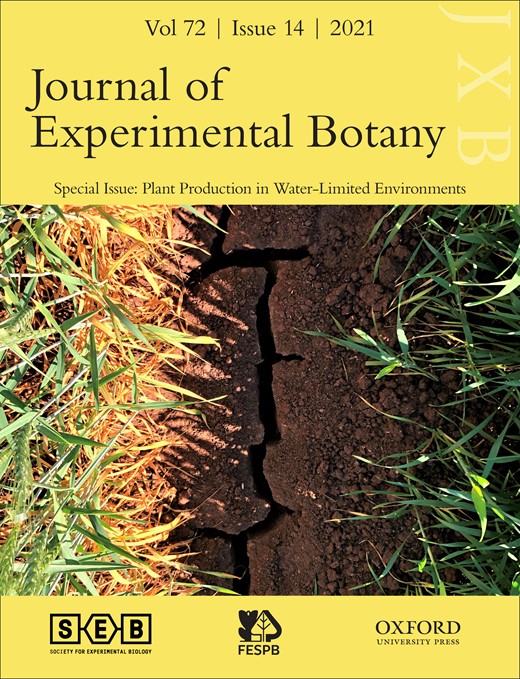
Cover image

Volume 72, Issue 14, 10 July 2021
Special Issue: Plant Production in Water-Limited Environments
eXtra Botany
Special Issue Editorial
Plant production in water-limited environments
REVIEW PAPERS
Bottlenecks and opportunities in field-based high-throughput phenotyping for heat and drought stress
This review focuses on developing high-throughput phenotyping approaches to quantify key physiological traits at high temporal frequency, involving diverse germplasm to incorporate greater heat and drought stress resilience in crops.
Recognizing the hidden half in wheat: root system attributes associated with drought tolerance
We review the root system architecture contributing to drought tolerance and key loci involved in the regulation of root traits, and hence provide information for genetic improvement in wheat breeding for drought tolerance.
Harnessing translational research in wheat for climate resilience
This review describes the scientific basis of a research and breeding pathway designed to boost genetic gains in wheat under drought and heat stress.
In pursuit of a better world: crop improvement and the CGIAR
This document arose from the urgent need to join forces (across nations and research disciplines) and stand together to improve the prospects for the most vulnerable population on the globe whose well-being depends on agricultural production. Here, we learn from the past, and draft future strategic guidelines that will facilitate efforts of the CGIAR institutions (https://www.cgiar.org/) to enhance the livelihoods of the less privileged through crop improvement.
Genetically modified maize hybrids and delayed sowing reduced drought effects across a rainfall gradient in temperate Argentina
Insect-protected transgenic maize allowed the option of delayed sowing in Argentina. This practice reduced the risk of drought around flowering, expanded the area of maize cultivation, and stabilized interannual grain yield.
Exploiting genotype × management interactions to increase rainfed crop production: a case study from south-eastern Australia
Advances in crop production are rarely attributable to a single innovation, but to synergistic combinations of management and genetics. Research should be structured and designed to capture these synergies.
RESEARCH PAPERS
Establishment method affects rice root plasticity in response to drought and its relationship with grain yield stability
Evaluation of a set of rice genotypes using different seedling establishment methods, water supply, and nitrogen application rates reveals complex interactions between yield stability and root architectural plasticity.
Transpiration efficiency: insights from comparisons of C4 cereal species
Comparisons among C4 maize, sorghum, and pearl millet show that soil type and source–sink balance affect transpiration efficiency under high vapor pressure deficit in a species-dependent manner.
Reproductive resilience but not root architecture underpins yield improvement under drought in maize
Emerging opportunity to continue long-term genetic gain in maize yield in the US corn belt by improving the balance between canopy, root, and reproductive growth and development.
Chloride nutrition improves drought resistance by enhancing water deficit avoidance and tolerance mechanisms
Chloride nutrition at macronutrient levels reduces stress symptoms and enhances plant growth during water deficit, promoting water deficit avoidance (water-use efficiency) and tolerance (osmoregulation) mechanisms that improve drought resistance.


